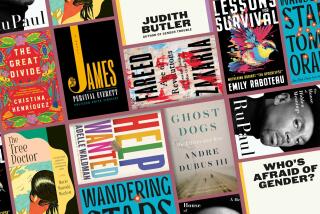Dark Passages: The lesson of a master
Note: This is the second of a two-part column on the current state of contemporary detective fiction. This month: One of the masters of the form talks about the detective story.
In order to understand and properly appreciate contemporary detective fiction, it is vital to look back to the past. That can be hard to do when one’s nominal occupation requires staying on top -- and reading many -- of the year’s releases, which total in the thousands in a given 12-month period. But even the shop-worn excuse of “too many books to read” wears thin after a while.
Still, this regrettable gap can be filled by an essay collection like Otto Penzler’s “The Lineup” (which Dark Passages reviewed last month) or a good reference book, like William DeAndrea’s “Encyclopedia Mysteriosa” (1994) or Julian Symons’ 1972 tome “Bloody Murder.” Or still, by the distinct perspective of one of the genre’s most important practitioners, who at the age of 89 engaged firsthand with mystery’s Golden Age as a reader and then, as a writer, put her own spin on her crime-writing ancestors.
“Talking About Detective Fiction” (Alfred A. Knopf: 204 pp., $22) should not be thought of as definitive, and P.D. James takes great pains to remind the reader not to read too deeply into her choices. It puzzled me, for example, that Josephine Tey garnered several pages of notice, but she was not included among the most pivotal of the Golden Age practitioners (James, instead, picked Christie, Allingham, Sayers and Marsh as her most deserving quartet), and when she was discussed, there was no mention of my own favorite book of Tey’s, “Daughter of Time.”
James does make a compelling case for why, like William Godwin’s “Caleb Williams” (1794), Wilkie Collins’ “The Moonstone” (1868) and the work of Arthur Conan Doyle and Edgar Allan Poe, Jane Austen’s “Emma” should be considered an early example of the detective story: “Here the secret which is the mainspring of the action is the unrecognized relationships between the limited number of characters . . . Austen deceives us with cleverly constructed clues . . . at the end, when all becomes plain and the characters are at last united with their right partners, we wonder how we could have been so deceived.”
From here on in, James provides the reader with a no-nonsense, pithy education on the bedrock of the detective novel, distinguished from other forms of fiction by “a highly organized structure and recognized conventions.” Her analysis of Agatha Christie astutely points to the lack of innovation but commends the author’s ability to produce a consistently “strong and exciting narrative, the challenge of a puzzle, an accommodating and accessible style and original detectives . . . whom readers can encounter in book after book with the comfortable assurance that they are meeting old friends.”
Sayers is given good marks for her foray into more realistic depictions of society, but James also reminds readers that Sayers was, like her peers, prone to overly complicated plots and outlandish murder scenes that contradict the “stupid and brutal” behavior of the fingered murderers.
Naturally, personal taste enters the equation a great deal, too. James admires Ian Rankin for daring to retire his police detective protagonist, John Rebus, when most authors -- herself included -- can’t bear to age their fictional constructs in real time. Sara Paretsky is “the most remarkable of the moderns,” which indicates taste as much as who James considers to be a contemporary detective novelist (Paretsky began her career nearly three decades ago). But James also believes that current economic and societal uncertainty creates enough grist for the mill to concoct a “New Golden Age” of detective fiction -- that both reflects society and provides comfort and escapism for those who need it most.
Of “the triumvirate of the best hard-boiled writers,” James prefers Ross Macdonald and his private eye, Lew Archer, more than Hammett & Chandler. (She does, however, point out why Hammett endures: “He showed crime writers that what is important goes beyond an ingenious plot, mystery and suspense.”) She admires Ngaio Marsh but also takes issue with “a less accurate, more idealized, nostalgic and regrettably sometimes snobbish picture of England than do her crime-writing contemporaries.”
“No writer, whatever form his fiction takes, can distance himself from the country, civilization and century of which he is a part.” James writes this passage in relation to the greats, but she applies it equally well to herself. A product of a between-the-wars middle-class English background, James in her work -- especially the Inspector Dalgliesh novels -- exhibits these influences in a way that marks them as both timeless and old-fashioned. But it hardly seems fair to ask James to keep up with nouveau detective fiction beyond necessary technological advancements for the sake of staying current -- that is a sure-fire way to date even more quickly.
Instead, “Talking About Detective Fiction,” whether or not one agrees with the specifics, is a good primer for fundamentals and well-earned wisdom. “Reading any work of fiction is a symbiotic act,” James writes, one in which readers and writers engage their imaginations in tandem to create a unique world wholly independent from either influence. Whether analyzed at great length or just by “talking” about it, here lies the power of detective fiction -- and this narrative investment is why this genre will endure.
Sarah Weinman blogs about crime and mystery fiction at www.sarahweinman.com. Dark Passages appears monthly at www.latimes.com/books.
More to Read
The biggest entertainment stories
Get our big stories about Hollywood, film, television, music, arts, culture and more right in your inbox as soon as they publish.
You may occasionally receive promotional content from the Los Angeles Times.






